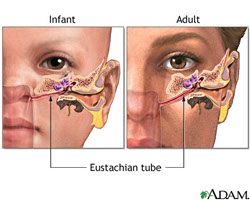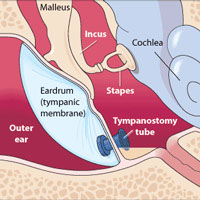Chronic Ear Infections & Tympanostomy Tubes

Children are sometimes prone to frequent and recurring ear infections due to “Eustachian tube dysfunction”. The Eustachian tube is a narrow channel connecting the inside of the ear to the back of the throat, just above the soft palate and uvula. The tube allows drainage of fluid from the middle ear, and also maintains middle ear pressure equal to the air outside the ear. Normally, the tube is collapsed most of the time in order to prevent the many germs residing in the nose and mouth from entering the middle ear. Infection occurs when the Eustachian tube fails to do its job, which leads to fluid accumulation in the middle ear, trapping bacteria already present, which then multiply.
Additionally, as the air in the middle ear space escapes into the bloodstream, a partial vacuum is formed that absorbs more bacteria from the nose and mouth into the ear. Children have Eustachian tubes that are shorter, floppier, more horizontal, and straighter than those of adults. These factors make the journey for the bacteria quick and relatively easy, and also make it more difficult for the ears to clear the fluid.
Tympanostomy tubes (myringotomy tubes, ventilation tubes, pressure equilzation tubes) are often recommended for patients presenting with recurring middle ear infections (acute otitis media) or hearing loss caused by the persistent presence of middle ear fluid (otitis media with effusion). Tympanostomy tubes are tiny cylinders placed through the eardrum (tympanic membrane) to allow air into the middle ear. There are two general types of ear tubes: short-term and long-term. Short-term tubes are smaller and typically stay in place for 6-18 months before falling out on their own. Long-term tubes are larger and have flanges that secure them in place for a longer period of time. Long-term tubes may fall out on their own or require removal at a later point. In certain cases removal of adenoid tissue (lymph tissue located in the upper airway behind the nose) can also help in decreasing the frequency of recurring ear infections. Adenoidectomy is often considered when a second or third tube insertion is necessary. Current research indicates that removing adenoid tissue concurrent with placement of ear tubes can reduce the risk of recurrent ear infections and the need for repeat surgery.

